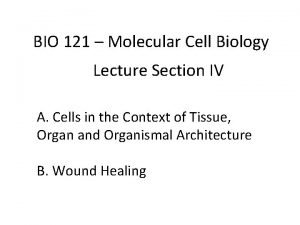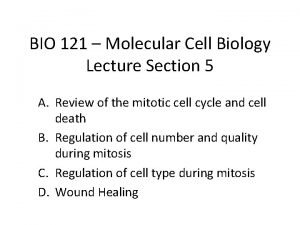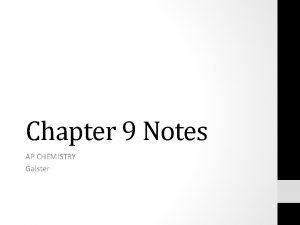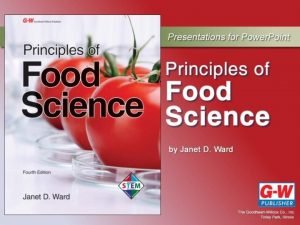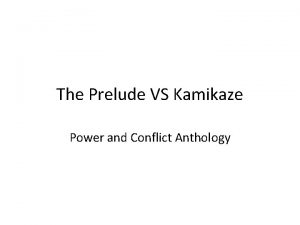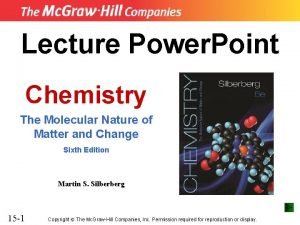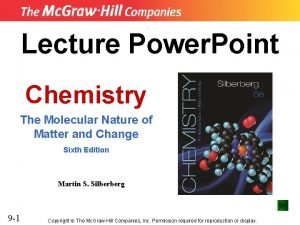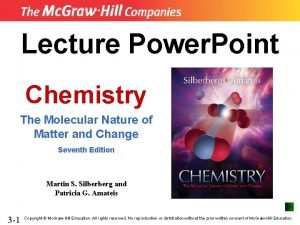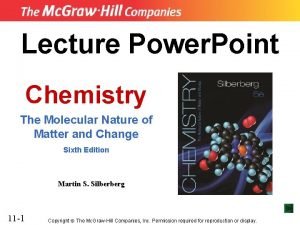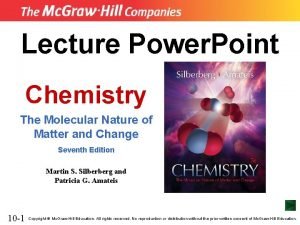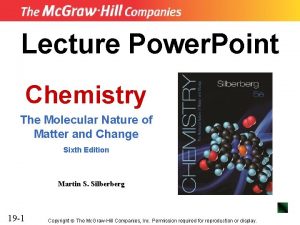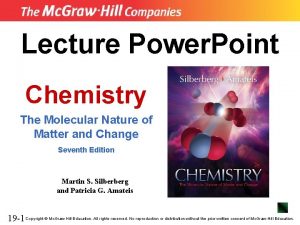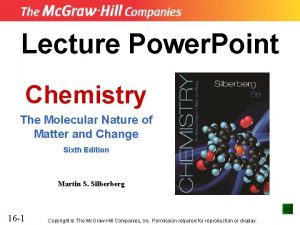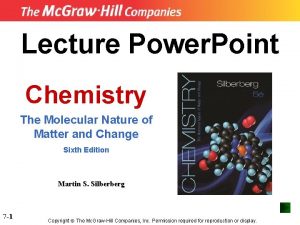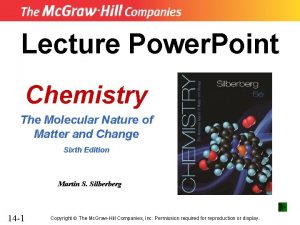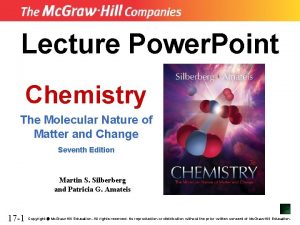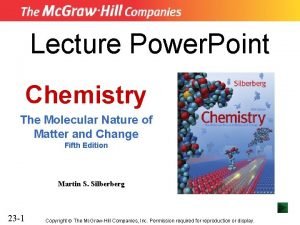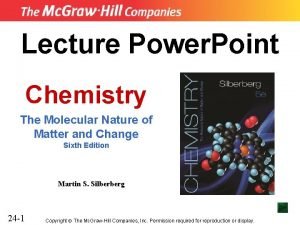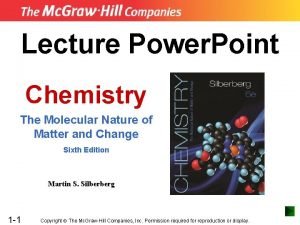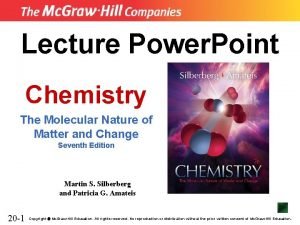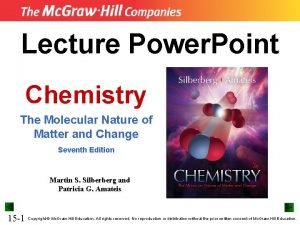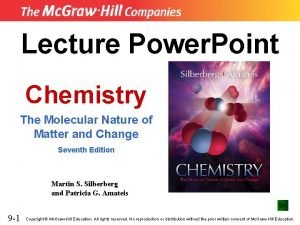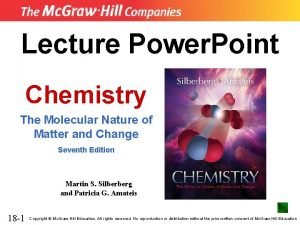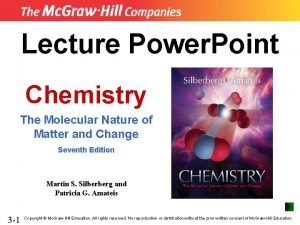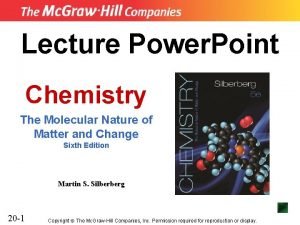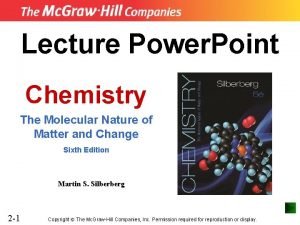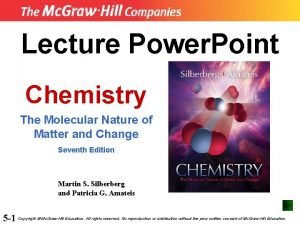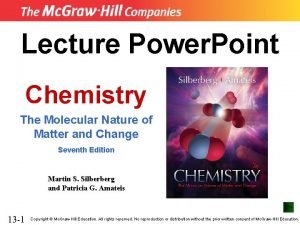Lecture Power Point Chemistry The Molecular Nature of





































































- Slides: 69

Lecture Power. Point Chemistry The Molecular Nature of Matter and Change Seventh Edition Martin S. Silberberg and Patricia G. Amateis 1 -1 Copyright Mc. Graw-Hill Education. All rights reserved. No reproduction or distribution without the prior written consent of Mc. Graw-Hill Education.

Chapter 1: Keys to the Study of Chemistry 1. 1 Some Fundamental Definitions 1. 2 Chemical Arts and the Origins of Modern Chemistry 1. 3 The Scientific Approach: Developing a Model 1. 4 Measurement and Chemical Problem Solving 1. 5 Uncertainty in Measurement: Significant Figures 1 -2

Chapter 1 Keys to the Study of Chemistry 1 -3

Chemistry is the study of matter, its properties, the changes that matter undergoes, and the energy associated with these changes. 1 -4

Definitions Matter anything that has both mass and volume – the “stuff” of the universe: books, planets, trees, professors, students Composition the types and amounts of simpler substances that make up a sample of matter Properties 1 -5 the characteristics that give each substance a unique identity

The States of Matter A solid has a fixed shape and volume. Solids may be hard or soft, rigid or flexible. A liquid has a varying shape that conforms to the shape of the container, but a fixed volume. A liquid has an upper surface. A gas has no fixed shape or volume and therefore does not have a surface. 1 -6

Figure 1. 1 1 -7 The physical states of matter.

Physical Properties properties a substance shows by itself without interacting with another substance – color, melting point, boiling point, density Chemical Properties properties a substance shows as it interacts with, or transforms into, other substances – flammability, corrosiveness 1 -8

Figure 1. 2 The distinction between physical and chemical change. 1 -9

Sample Problem 1. 1 Visualizing Change on the Atomic Scale PROBLEM: The scenes below represent an atomic-scale view of substance A undergoing two different changes. Decide whether each scene shows a physical or a chemical change. PLAN: 1 -10 We need to determine what change is taking place. The numbers and colors of the little spheres that represent each particle tell its “composition”. If the composition does not change, the change is physical, whereas a chemical change results in a change of composition.

Sample Problem 1. 1 SOLUTION: Each particle of substance A is composed of one blue and two red spheres. Sample B is composed of two different types of particles – some have two red spheres while some have one red and one blue. As A changes to B, the chemical composition has changed. A B is a chemical change. 1 -11

Sample Problem 1. 1 Each particle of C is still composed of one blue and two red spheres, but the particles are closer together and are more organized. The composition remains unchanged, but the physical form is different. A C is a physical change. 1 -12

Temperature and Change of State • A change of state is a physical change. – Physical form changes, composition does not. • Changes in physical state are reversible – by changing the temperature. • A chemical change cannot simply be reversed by a change in temperature. 1 -13

Table 1. 1 Some Characteristic Properties of Copper 1 -14

Sample Problem 1. 2 Distinguishing Between Physical and Chemical Change PROBLEM: Decide whether each of the following processes is primarily a physical or a chemical change, and explain briefly: (a) Frost forms as the temperature drops on a humid winter night. (b) A cornstalk grows from a seed that is watered and fertilized. (c) A match ignites to form ash and a mixture of gases. (d) Perspiration evaporates when you relax after jogging. (e) A silver fork tarnishes slowly in air. PLAN: 1 -15 “Does the substance change composition or just change form? ”

Sample Problem 1. 2 SOLUTION: (a) Frost forms as the temperature drops on a humid winter night. physical change (b) A cornstalk grows from a seed that is watered and fertilized. chemical change (c) A match ignites to form ash and a mixture of gases. chemical change (d) Perspiration evaporates when you relax after jogging. physical change (e) A silver fork tarnishes slowly in air. chemical change 1 -16

Energy in Chemistry Energy is the ability to do work. Potential Energy is energy due to the position of an object. Kinetic Energy is energy due to the movement of an object. Total Energy = Potential Energy + Kinetic Energy 1 -17

Energy Changes Lower energy states are more stable and are favored over higher energy states. Energy is neither created nor destroyed – it is conserved – and can be converted from one form to another. 1 -18

Figure 1. 3 A Potential energy is converted to kinetic energy. A gravitational system. The potential energy gained when a weight is lifted is converted to kinetic energy as the weight falls. A lower energy state is more stable. 1 -19

Figure 1. 3 B Potential energy is converted to kinetic energy. A system of two balls attached by a spring. The potential energy gained by a stretched spring is converted to kinetic energy when the moving balls are released. Energy is conserved when it is transformed. 1 -20

Figure 1. 3 C Potential energy is converted to kinetic energy. A system of oppositely charged particles. The potential energy gained when the charges are separated is converted to kinetic energy as the attraction pulls these charges together. 1 -21

Figure 1. 3 D Potential energy is converted to kinetic energy. A system of fuel and exhaust. A fuel is higher in chemical potential energy than the exhaust. As the fuel burns, some of its potential energy is converted to the kinetic energy of the moving car. 1 -22

Figure 1. 6 The scientific approach to understanding nature. Observations Hypothesis is revised if experimental results do not support it. Hypothesis Tentative proposal that explains observations Experiment Procedure to test hypothesis; measures one variable at a time Model (Theory) Model is altered if predicted events do not support it. 1 -23 Natural phenomena and measured events; can be stated as a natural law if universally consistent Further Experiment Set of conceptual assumptions that explains data from accumulated experiments; predicts related phenomena Tests predictions based on model

Table 1. 2 SI Base Units Physical Quantity (Dimension) Unit Name Mass kilogram kg Length meter m Time second s Temperature kelvin K Electric Current ampere A Amount of substance mole Luminous intensity candela 1 -24 Unit Abbreviation mol cd

Table 1. 3 1 -25 Common Decimal Prefixes Used with SI Units

Table 1. 4 Common SI-English Equivalent Quantities Quantity SI to English Equivalent English to SI Equivalent Length 1 km = 0. 6214 mile 1 m = 1. 094 yards 1 m = 39. 37 inches 1 cm = 0. 3937 inch 1 mi = 1. 609 km 1 yd = 0. 9144 m 1 ft = 0. 3048 m 1 in = 2. 54 cm Volume 1 cubic meter (m 3) = 35. 31 ft 3 1 dm 3 = 0. 2642 gal 1 dm 3 = 1. 057 qt 1 cm 3 = 0. 03381 fluid ounce 1 ft 3 = 0. 02832 m 3 1 gal = 3. 785 dm 3 1 qt = 0. 9464 dm 3 1 qt = 946. 4 cm 3 1 fluid ounce = 29. 57 cm 3 1 kg = 2. 205 lb 1 g = 0. 03527 ounce (oz) 1 lb = 0. 4536 kg 1 oz = 28. 35 g Mass 1 -26

Figure 1. 7 1 -27 Some volume relationships in SI.

Figure 1. 8 1 -28 Common laboratory volumetric glassware.

Figure 1. 9 1 -29 Some interesting quantities of length (A), volume (B), and mass (C).

Chemical Problem Solving • All measured quantities consist of – a number and a unit. • Units are manipulated like numbers: – 3 ft x 4 ft = 12 ft 2 – 350 mi = 7 h 1 -30 50 mi 1 h or 50 mi∙h-1

Conversion Factors A conversion factor is a ratio of equivalent quantities used to express a quantity in different units. The relationship 1 mi = 5280 ft gives us the conversion factor: 1 mi 5280 ft 1 -31 = 5280 ft =1

A conversion factor is chosen and set up so that all units cancel except those required for the answer. PROBLEM: The height of the Angel Falls is 3212 ft. Express this quantity in miles (mi) if 1 mi = 5280 ft. PLAN: Set up the conversion factor so that ft will cancel and the answer will be in mi. SOLUTION: 1 -32 3212 ft x 1 mi 5280 ft = 0. 6083 mi

Systematic Approach to Solving Chemistry Problems • State Problem Clarify the known and unknown. • Plan • Solution Suggest steps from known to unknown. Prepare a visual summary of steps that includes conversion factors, equations, known variables. • Check • Comment • Follow-up Problem 1 -33

Sample Problem 1. 3 Converting Units of Length PROBLEM: To wire your stereo equipment, you need 325 centimeters (cm) of speaker wire that sells for $0. 15/ft. What is the price of the wire? PLAN: We know the length (in cm) of wire and cost per length ($/ft). We have to convert cm to inches and inches to feet. Then we can find the cost for the length in feet. Length (cm) of wire 2. 54 cm = 1 in Length (in) of wire 12 in = 1 ft Length (ft) of wire 1 ft = $0. 15 Cost ($) of wire 1 -34

Sample Problem 1. 3 SOLUTION: Length (in) = length (cm) x conversion factor 1 in = 325 cm x = 128 in 2. 54 cm Length (ft) = length (in) x conversion factor = 128 in x 1 ft = 10. 7 ft 12 in Price ($) = length (ft) x conversion factor = 10. 7 ft x 1 -35 $ 0. 15 1 ft = $ 1. 60

Sample Problem 1. 4 Converting Units of Volume PROBLEM: A graduated cylinder contains 19. 9 m. L of water. When a small piece of galena, an ore of lead, is added, it sinks and the volume increases to 24. 5 m. L. What is the volume of the piece of galena in cm 3 and in L? PLAN: The volume of the galena is equal to the difference in the volume of the water before and after the addition. Volume (m. L) before and after subtract Volume (m. L) of galena 1 m. L = 1 cm 3 Volume (cm 3) of galena 1 -36 1 m. L = 10 -3 L Volume (L) of galena

Sample Problem 1. 4 SOLUTION: (24. 5 - 19. 9) m. L = volume of galena = 4. 6 m. L 1 -37 1 cm 3 4. 6 m. L x 1 m. L = 4. 6 cm 3 10 -3 L 4. 6 m. L x 1 m. L = 4. 6 x 10 -3 L

Sample Problem 1. 5 Converting Units of Mass PROBLEM: Many international computer communications are carried out by optical fibers in cables laid along the ocean floor. If one strand of optical fiber weighs 1. 19 x 10 -3 lb/m, what is the mass (in kg) of a cable made of six strands of optical fiber, each long enough to link New York and Paris (a distance of 8. 94 x 103 km)? PLAN: The sequence of steps may vary but essentially we need to find the length of the entire cable and convert it to mass. Length (km) of fiber 1 km = 103 m Length (m) of fiber 1 m = 1. 19 x 10 -3 lb Mass (lb) of fiber 6 fibers = 1 cable Mass (lb) of cable 1 -38 2. 205 lb = 1 kg Mass (kg) of cable

Sample Problem 1. 5 SOLUTION: 8. 84 x 103 km 103 m x 1 km = 8. 84 x 106 m -3 lb 1. 19 x 10 8. 84 x 106 m x = 1. 05 x 104 lb 1 m 1. 05 x 104 lb 6 fibers x 1 fiber 1 cable 1 kg 6. 30 x 104 lb x 2. 205 lb 1 cable 1 -39 = 6. 30 x 104 lb/cable = 2. 86 x 104 kg/cable

Sample Problem 1. 6 Converting Units Raised to a Power PROBLEM: A furniture factory needs 31. 5 ft 2 of fabric to upholster one chair. Its Dutch supplier sends the fabric in bolts that hold exactly 200 m 2. How many chairs can be upholstered with three bolts of fabric? PLAN: We know the amount of fabric in one bolt in m 2; multiplying the m 2 of fabric by the number of bolts gives the total amount of fabric available in m 2. We convert the amount of fabric from m 2 to ft 2 and use the conversion factor 31. 5 ft 2 of fabric = 1 chair to find the number of chairs (see the road map). 1 -40

Sample Problem 1. 6 Copyright Mc. Graw-Hill Education. All rights reserved. No reproduction or distribution without the prior written consent of Mc. Graw-Hill Education. 1 -41

Sample Problem 1. 6 SOLUTION: Converting from number of bolts to amount of fabric in m 2: 200 m 2 Amount (m 2) of fabric = 3 bolts x = 600 m 2 1 bolt Converting the amount of fabric from m 2 to ft 2: Since 0. 3048 m = 1 ft, we have (0. 3048)2 m 2 = (1)2 ft 2, so Amount (ft 2) of fabric = 600 m 2 x 1 ft 2 (0. 3048)2 m 2 = 6460 ft 2 Finding the number of chairs: Number of chairs = 6460 1 -42 ft 2 x 1 chair 31. 5 ft 2 = 205 chairs

Density mass density = volume At a given temperature and pressure, the density of a substance is a characteristic physical property and has a specific value. 1 -43

Table 1. 5 Densities of Some Common Substances* Substance Physical State Density (g/cm 3) Hydrogen gas 0. 0000899 Oxygen gas 0. 00133 Grain alcohol liquid 0. 789 Water liquid 0. 998 Table salt solid 2. 16 Aluminum solid 2. 70 Lead solid 11. 3 Gold solid 19. 3 *At 1 -44 room temperature (20°C) and normal atmospheric pressure (1 atm).

Sample Problem 1. 7 Calculating Density from Mass and Length PROBLEM: Lithium, a soft, gray solid with the lowest density of any metal, is a key component of advanced batteries. A slab of lithium weighs 1. 49 x 103 mg and has sides that are 20. 9 mm by 11. 1 mm by 11. 9 mm. Find the density of lithium in g/cm 3. PLAN: Density is expressed in g/cm 3 so we need the mass in g and the volume in cm 3. Lengths (mm) of sides 10 mm = 1 cm Mass (mg) of Li Lengths (cm) of sides 103 mg = 1 g multiply lengths Mass (g) of Li Volume (cm 3) divide mass by volume Density (g/cm 3) of Li 1 -45

Sample Problem 1. 7 SOLUTION: -3 g 10 1. 49 x 103 mg x = 1. 49 g 1 mg 20. 9 mm x 1 cm = 2. 09 cm 10 mm Similarly the other sides will be 1. 11 cm and 1. 19 cm, respectively. Volume = 2. 09 cm x 1. 11 cm x 1. 19 cm = 2. 76 cm 3 Density of Li = 1 -46 1. 49 g 2. 76 cm 3 = 0. 540 g/cm 3

Figure 1. 10 Some interesting temperatures. 1 -47

Figure 1. 11 Freezing and boiling points of water in the Celsius, Kelvin (absolute) and Fahrenheit scales. 1 -48

Table 1. 6 The Three Temperature Scales 1 -49

Temperature Scales Kelvin ( K ) – The “absolute temperature scale” begins at absolute zero and has only positive values. Note that the kelvin is not used with the degree sign (°). Celsius ( o. C ) – The Celsius scale is based on the freezing and boiling points of water. This is the temperature scale used most commonly around the world. The Celsius and Kelvin scales use the same size degree although their starting points differ. Fahrenheit ( o. F ) – The Fahrenheit scale is commonly used in the U. S. The Fahrenheit scale has a different degree size and different zero points than both the Celsius and Kelvin scales. 1 -50

Temperature Conversions T (in K) = T (in o. C) + 273. 15 T (in o. C) = T (in K) – 273. 15 T (in °F) = 9 T (in °C) + 32 5 T (in °C) = [T (in °F) – 32] 1 -51 5 9

Sample Problem 1. 8 Converting Units of Temperature PROBLEM: A child has a body temperature of 38. 7°C, and normal body temperature is 98. 6°F. Does the child have a fever? What is the child’s temperature in kelvins? PLAN: We have to convert °C to °F to find out if the child has a fever. We can then use the °C to Kelvin relationship to find the temperature in Kelvin. SOLUTION: Converting from °C to °F 9 (38. 7 °C) + 32 = 101. 7 °F 5 Yes, the child has a fever. Converting from °C to K 1 -52 38. 7 °C + 273. 15 = 311. 8 K

Significant Figures Every measurement includes some uncertainty. The rightmost digit of any quantity is always estimated. The recorded digits, both certain and uncertain, are called significant figures. The greater the number of significant figures in a quantity, the greater its certainty. 1 -53

Figure 1. 12 1 -54 The number of significant figures in a measurement.

Determining Which Digits are Significant All digits are significant – except zeros that are used only to position the decimal point. • Make sure the measured quantity has a decimal point. • Start at the left and move right until you reach the first nonzero digit. • Count that digit and every digit to its right as significant. 1 -55

• Zeros that end a number are significant – whether they occur before or after the decimal point – as long as a decimal point is present. • 1. 030 m. L has 4 significant figures. • 5300. L has 4 significant figures. • If no decimal point is present – zeros at the end of the number are not significant. • 5300 L has only 2 significant figures. 1 -56

Sample Problem 1. 9 Determining the Number of Significant Figures PROBLEM: For each of the following quantities, underline the zeros that are significant figures (sf), and determine the number of significant figures in each quantity. For (d) to (f), express each in exponential notation first. (a) 0. 0030 L (b) 0. 1044 g (c) 53, 069 m. L (d) 0. 00004715 m PLAN: 1 -57 (e) 57, 600. s (f) 0. 0000007160 cm 3 We determine the number of significant figures by counting digits, paying particular attention to the position of zeros in relation to the decimal point, and underline zeros that are significant.

Sample Problem 1. 9 SOLUTION: (a) 0. 0030 L has 2 sf (b) 0. 1044 g has 4 sf (c) 53, 069 m. L has 5 sf (d) 0. 00004715 m = 4. 715 x 10 -5 m has 4 sf (e) 57, 600. s = 5. 7600 x 104 s has 5 sf (f) 0. 0000007160 cm 3 = 7. 160 x 10 -7 cm 3 has 4 sf 1 -58

Rules for Significant Figures in Calculations 1. For multiplication and division. The answer contains the same number of significant figures as there are in the measurement with the fewest significant figures. Multiply the following numbers: 9. 2 cm x 6. 8 cm x 0. 3744 cm = 23. 4225 cm 3 = 23 cm 3 1 -59

Rules for Significant Figures in Calculations 2. For addition and subtraction. The answer has the same number of decimal places as there are in the measurement with the fewest decimal places. Example: adding two volumes 83. 5 m. L + 23. 28 m. L 106. 78 m. L = 106. 8 m. L Example: subtracting two volumes 865. 9 m. L - 2. 8121 m. L 863. 0879 m. L = 863. 1 m. L 1 -60

Rules for Rounding Off Numbers 1. If the digit removed is more than 5, the preceding number increases by 1. 5. 379 rounds to 5. 38 if 3 significant figures are retained. 2. If the digit removed is less than 5, the preceding number is unchanged. 0. 2413 rounds to 0. 241 if 3 significant figures are retained. 1 -61

3. If the digit removed is 5 followed by zeros or with no following digits, the preceding number increases by 1 if it is odd and remains unchanged if it is even. 17. 75 rounds to 17. 8, but 17. 65 rounds to 17. 6. If the 5 is followed by other nonzero digits, rule 1 is followed: 17. 6500 rounds to 17. 6, but 17. 6513 rounds to 17. 7 4. Be sure to carry two or more additional significant figures through a multistep calculation and round off the final answer only. 1 -62

Figure 1. 13 Significant figures and measuring devices. The measuring device used determines the number of significant digits possible. 1 -63

Exact Numbers Exact numbers have no uncertainty associated with them. Numbers may be exact by definition: 1000 mg = 1 g 60 min = 1 hr 2. 54 cm = 1 in Numbers may be exact by count: exactly 26 letters in the alphabet Exact numbers do not limit the number of significant digits in a calculation. 1 -64

Sample Problem 1. 10 Significant Figures and Rounding PROBLEM: Perform the following calculations and round each answer to the correct number of significant figures: (a) 16. 3521 cm 2 - 1. 448 7. 085 cm cm 2 4. 80 x 104 (b) mg 1 g 1000 mg 11. 55 cm 3 PLAN: We use the rules for rounding presented in the text: (a) We subtract before we divide. (b) We note that the unit conversion involves an exact number. 1 -65

Sample Problem 1. 10 SOLUTION: (a) 16. 3521 cm 2 - 1. 448 cm 2 7. 085 cm (b) 4. 80 x 104 mg 1 g 1000 mg 11. 55 cm 3 1 -66 = 14. 904 cm 2 7. 085 cm = = 2. 104 cm 48. 0 g 11. 55 cm 3 = 4. 16 g/cm 3

Precision, Accuracy, and Error Precision refers to how close the measurements in a series are to each other. Accuracy refers to how close each measurement is to the actual value. Systematic error produces values that are either all higher or all lower than the actual value. This error is part of the experimental system. Random error produces values that are both higher and lower than the actual value. 1 -67

Figure 1. 14 Precision and accuracy in a laboratory calibration. precise and accurate precise but not accurate 1 -68

Figure 1. 14 Precision and accuracy in the laboratory. continued random error systematic error 1 -69
 01:640:244 lecture notes - lecture 15: plat, idah, farad
01:640:244 lecture notes - lecture 15: plat, idah, farad Molecular biology lectures
Molecular biology lectures Enteroendocrine cell
Enteroendocrine cell Diapedesis
Diapedesis What is a covalent bond simple definition
What is a covalent bond simple definition Giant molecular structure vs simple molecular structure
Giant molecular structure vs simple molecular structure Giant molecular structure vs simple molecular structure
Giant molecular structure vs simple molecular structure Power triangle formula
Power triangle formula Powerbi in powerpoint
Powerbi in powerpoint Point point power
Point point power Advanced inorganic chemistry lecture notes
Advanced inorganic chemistry lecture notes Lightning elves
Lightning elves Fifth edition chemistry a molecular approach
Fifth edition chemistry a molecular approach Ap chemistry molecular geometry
Ap chemistry molecular geometry Power system dynamics and stability lecture notes
Power system dynamics and stability lecture notes Zline 667-36
Zline 667-36 Power semiconductor devices lecture notes
Power semiconductor devices lecture notes Switch mode power supply lecture notes
Switch mode power supply lecture notes Power system dynamics and stability lecture notes
Power system dynamics and stability lecture notes Customs in things fall apart
Customs in things fall apart Nature and nature's laws lay hid in night meaning
Nature and nature's laws lay hid in night meaning Nature nature controversy
Nature nature controversy Non examples of homogeneous mixture
Non examples of homogeneous mixture Chapter 4 basic food chemistry the nature of matter
Chapter 4 basic food chemistry the nature of matter Foods that are heterogeneous mixtures
Foods that are heterogeneous mixtures Ib chemistry organic chemistry
Ib chemistry organic chemistry Inorganic chemistry vs organic chemistry
Inorganic chemistry vs organic chemistry Hình ảnh bộ gõ cơ thể búng tay
Hình ảnh bộ gõ cơ thể búng tay Ng-html
Ng-html Bổ thể
Bổ thể Tỉ lệ cơ thể trẻ em
Tỉ lệ cơ thể trẻ em Voi kéo gỗ như thế nào
Voi kéo gỗ như thế nào Tư thế worm breton
Tư thế worm breton Hát lên người ơi alleluia
Hát lên người ơi alleluia Các môn thể thao bắt đầu bằng tiếng đua
Các môn thể thao bắt đầu bằng tiếng đua Thế nào là hệ số cao nhất
Thế nào là hệ số cao nhất Các châu lục và đại dương trên thế giới
Các châu lục và đại dương trên thế giới Công thức tính thế năng
Công thức tính thế năng Trời xanh đây là của chúng ta thể thơ
Trời xanh đây là của chúng ta thể thơ Mật thư anh em như thể tay chân
Mật thư anh em như thể tay chân Phép trừ bù
Phép trừ bù độ dài liên kết
độ dài liên kết Các châu lục và đại dương trên thế giới
Các châu lục và đại dương trên thế giới Thơ thất ngôn tứ tuyệt đường luật
Thơ thất ngôn tứ tuyệt đường luật Quá trình desamine hóa có thể tạo ra
Quá trình desamine hóa có thể tạo ra Một số thể thơ truyền thống
Một số thể thơ truyền thống Bàn tay mà dây bẩn
Bàn tay mà dây bẩn Vẽ hình chiếu vuông góc của vật thể sau
Vẽ hình chiếu vuông góc của vật thể sau Thế nào là sự mỏi cơ
Thế nào là sự mỏi cơ đặc điểm cơ thể của người tối cổ
đặc điểm cơ thể của người tối cổ Ví dụ giọng cùng tên
Ví dụ giọng cùng tên Vẽ hình chiếu đứng bằng cạnh của vật thể
Vẽ hình chiếu đứng bằng cạnh của vật thể Phối cảnh
Phối cảnh Thẻ vin
Thẻ vin đại từ thay thế
đại từ thay thế điện thế nghỉ
điện thế nghỉ Tư thế ngồi viết
Tư thế ngồi viết Diễn thế sinh thái là
Diễn thế sinh thái là Các loại đột biến cấu trúc nhiễm sắc thể
Các loại đột biến cấu trúc nhiễm sắc thể Số nguyên là gì
Số nguyên là gì Tư thế ngồi viết
Tư thế ngồi viết Lời thề hippocrates
Lời thề hippocrates Thiếu nhi thế giới liên hoan
Thiếu nhi thế giới liên hoan ưu thế lai là gì
ưu thế lai là gì Khi nào hổ con có thể sống độc lập
Khi nào hổ con có thể sống độc lập Khi nào hổ con có thể sống độc lập
Khi nào hổ con có thể sống độc lập Hệ hô hấp
Hệ hô hấp Từ ngữ thể hiện lòng nhân hậu
Từ ngữ thể hiện lòng nhân hậu Thế nào là mạng điện lắp đặt kiểu nổi
Thế nào là mạng điện lắp đặt kiểu nổi Kamikaze power of nature
Kamikaze power of nature


